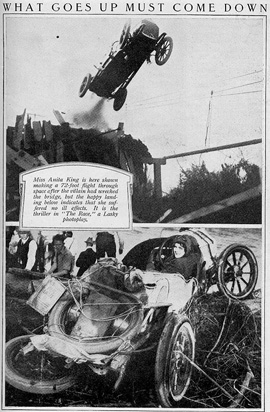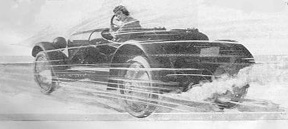 newly-formed corporation that combined Adolph Zukor's Famous Players studio in New York and Jesse Lasky's company in Hollywood. A dark-haired, dark-eyed stunner from Chicago, Anita King was originally a protegee of Lillian Russell with theatrical ambitions. She was left some property in Mexico bequeathed her by her late mother and had a narrow escape while fleeing the Mexican Revolution when rebels held up her train. Returning to the United States, she found a new interest. Wrote Kenneth McGaffey, the publicist for the Lasky company: "Automobile racing was just then becoming popular, so she secured a position as demonstrator with a Los Angeles firm and then took up racing" at a time when women race drivers were virtually non-existent. Anita King may hold the distinction of having been the first woman race driver on the West Coast. "Miss King entered a number of events and won several and finally, in Phoenix, at a race meet, she was hurled through the fence while driving at top speed and nearly lost her life." (62)
newly-formed corporation that combined Adolph Zukor's Famous Players studio in New York and Jesse Lasky's company in Hollywood. A dark-haired, dark-eyed stunner from Chicago, Anita King was originally a protegee of Lillian Russell with theatrical ambitions. She was left some property in Mexico bequeathed her by her late mother and had a narrow escape while fleeing the Mexican Revolution when rebels held up her train. Returning to the United States, she found a new interest. Wrote Kenneth McGaffey, the publicist for the Lasky company: "Automobile racing was just then becoming popular, so she secured a position as demonstrator with a Los Angeles firm and then took up racing" at a time when women race drivers were virtually non-existent. Anita King may hold the distinction of having been the first woman race driver on the West Coast. "Miss King entered a number of events and won several and finally, in Phoenix, at a race meet, she was hurled through the fence while driving at top speed and nearly lost her life." (62)After she left the hospital, Anita became a motion picture actress, joining the new Lasky studio in Hollywood headed by Cecil B. DeMille. She played supporting parts in early DeMille classics like The Virginian (1914) and Carmen (1915). Then, in 1915, the studio promoted her to stardom and began billing her as "The Paramount Girl."
Just as her fortunes in films began to rise, she suffered a personal loss that triggered her decision to undertake a remarkable exploit. In an article on Anita for Sunset Magazine, "A Little Mother of the Movies," Charles K. Field writes:
On a summer day in 1915 outside the Lasky studio, Anita King started the engine of her six-cylinder Kissel Kar, a big touring model, and headed north on the first leg of her journey. Given the backward state of many roads in those days before the post-World War I boom in highway construction transformed the country, she faced an arduous, even hazardous passage. The New York Dramatic Mirror ran the following article on her departure:
On Wednesday, Aug. 25, Anita King, known as "The Paramount Girl," left the Los Angeles studio of the Lasky studios in a high-powered automobile to make the trip across the continent, unaccompanied except by a large English bulldog. When last heard from she had broken the record between Los Angeles and San Francisco by ten minutes. This is a remarkable performance, especially for a woman, for it is a rough mountain road, with few opportunities for real speed.
On her way across the continent she will stop at the Paramount theaters en route and tell the audiences all about how moving pictures, and especially Paramount pictures, are made. She is also the bearer of messages from the Mayors of Los Angeles and San Francisco to the Mayor of New York.
The trip is extremely dangerous. While crossing the desert she will be out of touch with civilization for two days at a time. In numerous places where there are no hotel accomodations she will have to camp out for the night. From Reno to Ely and Ely to Salt Lake City the trail across the desert is cumbered with deep sand, and she will be lucky if she makes as much as fifty miles a day.
Her itinerary includes San Francisco, Sacramento, Truckee, Reno, Fallon, Austin, Ely, Fish Springs, Salt Lake City, Green River, Rawlins, Laramie, Kimball, North Platte, Grand Island, Omaha, Boone, Cedar Rapids, Dixon, Chicago, Valparaiso, South Bend, Elkhart, Fort Wayne, Delphos, Lima, Dayton, Springfield, London, Columbus, Zanesville, Wheeling, Pittsburgh, Greensburg, Bedford, Chambersburg, Hanover, York, Columbia, Lancaster, Coatesville, Westchester, Philadelphia, Camden, Trenton, Princeton, New Brunswick, Elizabeth, and New York."(65)
'After leaving San Francisco, I stopped at Sacramento, and the second day passed over the Sierra Mountains, stopping at Truckee. The third day I arrived at Reno, where I was wonderfully received by the Mayor and a large party. I took many pictures at Reno with the camera, which is my only companion on my transcontinental trip. The Mayor presented me with a key to Reno. I appeared at the Grand Theatre. The house was packed and everybody was very enthusiastic. Leaving Reno on what is known as the Lovelock Road, which is impassable in wet weather, ten miles from Lincoln Highway, I got stuck in the mud. There had been a big cloudburst, but I did not know it, and I worked from 9 o'clock in the morning until 8 o'clock that night shoveling mud. I got the car out, drove fifty feet, and was stuck again. It was impossible for me to go on, and I had no food with me as I expected to make Fallon in four hours. I was exhausted so I got blankets out to lie down.
'About midnight a mad coyote attacked me, and after a terrible struggle I finally killed him, and knew nothing more until I was picked up by prospectors, who heard the shots of my gun. This was 3:30 A.M., so I must have fought with the coyote for three hours. The prospectors took me eighteen miles to a station house and gave me food. When I fully recovered I went back and got my car and followed the prospectors to Lovelock. Then I continued on my journey. The roads were terrible, so hot and dusty, that it took me nine hours to drive 80 and a half miles to Winnemucca.'"(66)
On "a lonely rain-swept hill in Wyoming," Anita had an encounter that would fill her with a new sense of purpose. She was heading towards a small town late in the afternoon after a long day's drive when she was stopped by a sixteen-year-old farm girl who begged the actress to take her along in her car. The movie-struck girl was at odds with her mother over her ambition to be in pictures. But Anita persuaded the girl to wait until she had completed her education before attempting to go into films. She explained the situation to the girl's mother and asked her to be sympathetic to her daughter's aspirations. Having thus established peace in the family, Anita bade a "happy farewell" to the girl in the rain. Then she "drove on through the wet twilight toward the neighboring town with a new idea of life," a wish to help the screen-struck girls who were starting to pour into Hollywood at an alarming rate. (68)
The Paramount Girl continued her journey, over the Great Plains, across the Mississippi, through hills and prairies and in great cities, stopping, as always, in theaters to speak about filmmaking. In October, she finally reached her destination as reported in The New York Dramatic Mirror:
Paramount Girl Completes Daring Cross Country Trip in Auto
Anita King, the Paramount Girl, arrived in New York last week, having traveled across the continent alone, driving a six-cylinder Kissel Kar. She was received at the 129th Street Ferry by a delegation and escorted to the City Hall, where she delivered to Mayor Mitchell a message from the Mayor of San Francisco and messages from the mayors of the other cities through which she passed. Following this ceremony the party adjourned to the Knickerbocker Hotel, where a luncheon was served. Miss King received a large silver cup from the Kissel Kar Company in commemoration of her trip. Among those present were W. W. Hodkinson, president of the Paramount Pictures Corporation; Samuel B. Goldfish (69), treasurer of the Jesse L. Lasky Feature Play Company, and Russell L. Engs, local agent of the Kissel Kar."(70)
"Having thoroughly recovered from the severe physical and mental strain of the long tour," Anita starred in a film based on her epochal trip, The Race. (72) Directed by George Melford for Lasky in 1916, her leading man was the famous comedian, Victor Moore, who had previously co-starred with Anita in Chimmie Fadden and Snobs in 1915. The Race cast Anita as a woman chauffeur who wins a transcontinental auto race. The actress did all her own stunts and in the most thrilling scene, she drove her car off a broken bridge at sixty-five miles an hour, "landing miraculously right-side-up while the camera man ground busily at a safe distance." (73)
Another legacy from her journey stemmed from her experience with the movie-struck girl in Wyoming. She began going to high schools and department stores speaking to girls ambitious for a film career. She reminded them as she had the Wyoming girl of the need for education and training before trying to work in pictures. For her efforts, she was made a Deputy City Mother of Los Angeles. With her new position, she organized a recreation club for the girls who were working in the studios and spoke out against advertisers who lured young girls to Hollywood with fraudulent promises of instant success. (74)
At the same time, she continued with her acting career, winning acclaim for her performances opposite leading man (and fellow race car enthusiast) Wallace Reid in the 1917 Lasky features, The Golden Fetter and The Squaw Man's Son. Some of the films she made for Triangle after leaving Paramount include Petticoats and Politics (1918), presenting a suffragette theme in a western setting, and Mistaken Identity (1919) in which she again played a victorious racing car driver. But after the teens she left acting and by the mid-twenties was working on scenarios. Interviewed a decade after her transcontinental journey, Anita reflected with amusement on the extent to which road conditions had changed. With the improvement in highways, she said it now took her only a few days to drive across the country in contrast to the weeks she had spent on the road in 1915. In fact, the publicity from the rigors of her pioneering cross-country trip had contributed to public awareness of the need for better highways.
